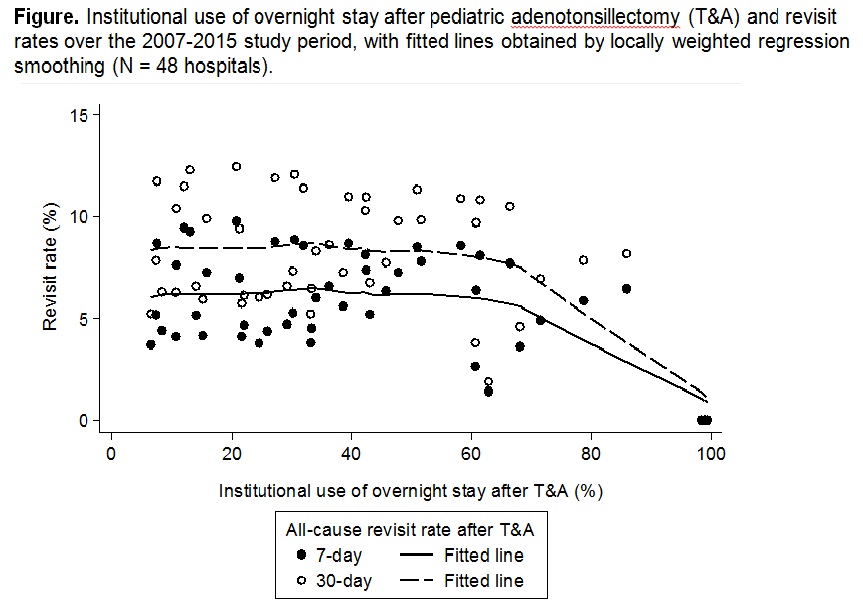RRA-6
Readmission rates following adenotonsillectomy in pediatric patients: Trends at major pediatric hospitals.
1Walia H, 2 Alsuhebani M, 3Miller R, 3Tumin D, 3Tobias J, 3Raman V
1Nationwide Childrens,, Columbus, Ohio, USA; 2Nationwide Childrens Hopsital, Columbus, Ohio, USA; 3Nationwide Childrens Hospital, Columbus, Ohio, USA
Introduction: Overnight admission can improve the safety of adenotonsillectomy (T&A) in the pediatric patient and may reduce the need for unplanned revisits following hospital discharge. We sought to examine whether admission practices favoring overnight stay after T&A in children were associated with a lower likelihood of all-cause revisits in a multi-center registry.
Methods: T&A performed in children age ≤18 years in 2007-2015 were identified in the Pediatric Health Information System (PHIS). The primary outcome was 7-day, all-cause readmission or emergency department revisit. Secondary analysis examined specific revisit types and 30-day revisits. The primary exposure was each institution’s annual rate of overnight stay after T&A. Mixed-effects logistic regression models were fitted to determine if institutional differences in admission practices after T&A were associated with the risk of revisits after this procedure.
Results: The analysis included 411,876 procedures at 48 hospitals (344,525 with complete study data). Hospitals’ annual rates of overnight stay ranged from 3% to 100%, and 7-day revisit rates varied from 0% to 15%. The most common specific reasons for 7 day revisits were dehydration, bleeding and pain. In multivariable analysis, individual inpatient admission predicted a lower odds of 7-day revisits (OR = 0.75; 95% CI: 0.72, 0.77; p<0.001). However, 7-day revisit rates did not differ between institutions that admitted more as opposed to fewer patients after T&A for overnight stay (Figure). At hospitals favoring overnight admission after T&A, 7-day revisits were more likely to take the form of inpatient admission rather than an ED visit. Regardless of postoperative admission practices, no differences were noted in 30-day revisits.
Conclusions: Pediatric hospitals vary widely in admission practices following T&A, such that some institutions still perform T&A as a mostly inpatient procedure, while others nearly always discharge patients on the day of service. Our results reveal that these differences in practice contribute little to explaining the much narrower range of variation in institutional revisit rates after T&A. Rather, institutional preference for overnight admission after T&A is associated with the type of revisits, where patients returning after the procedure are readmitted as inpatients rather than seen in the emergency department. These findings suggest that current judicious use of overnight stay performs well at reducing the risk of early revisits, notwithstanding practice variations across free-standing pediatric hospitals.
Top












